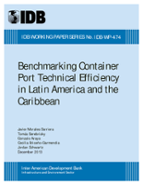Benchmarking Container Port Technical Efficiency in Latin America and the Caribbean
Date
Dec 2013
Data
We developed a technical efficiency analysis of container ports in Latin America and the Caribbean using an input-oriented stochastic frontier model. We employed a 10-year panel with data on container throughput, port terminal area, berth length, and number of available cranes in 63 ports. The model has three innovations with respect to the available literature: (i) we treated ship-to-shore gantry cranes and mobile cranes separately, in order to account for the higher productivity of the former; (ii) we introduced a binary variable for ports using ships¿ cranes, treated as an additional source of port productivity; and (iii) we introduced a binary variable for ports operating as transshipment hubs. Their associated parameters are highly significant in the production function. The results show an improvement in the average technical efficiency of ports in the Latin American and Caribbean region from 36% to 50% between 1999 and 2009; the best performing port in 2009 achieved a technical efficiency of 94%with respect to the frontier. The paper also studies possible determinants of port technical efficiency, such as ownership, corruption, transshipment, income per capita, and location. The results revealed positive and significant associations between technical efficiency and both transshipment activities and lower corruption levels.
NO




